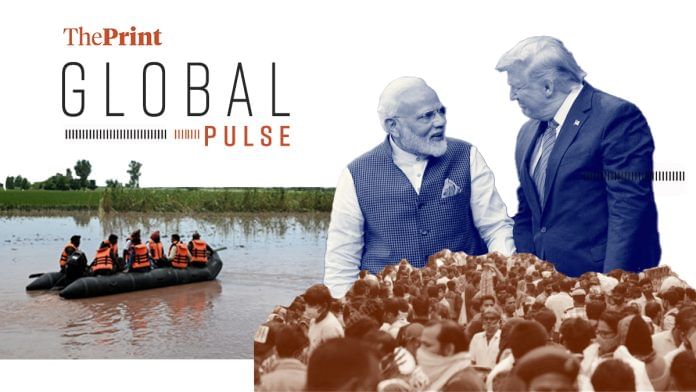New Delhi: The New York Times’ Mujib Mashal offers an analysis of the current status of the Trump-Modi relationship, and where the Indian Prime Minister stands now. “As he seeks to stop the rapid erosion of ties with Washington, officials and analysts say, Mr. Modi has now adopted a strategy of avoiding public confrontation with US officials as much possible, while also jumping at any opportunity to improve relations with Mr. Trump to help weather the storm,” he writes.
But, he adds, Modi’s strategy is not very different from how he “responded to aggression from China’s president, Xi Jinping, a few years ago when Beijing, to the embarrassment of Mr. Modi’s extended hand, piled troops on the Indian border”. And the newfound India-China warmth needs to be taken with a pinch of salt.
“…While the downturn in US relations has accelerated India’s rapprochement with China, Indian officials are clear that they remain fundamentally wary of Beijing’s intentions,” Mujib writes.
But what’s transpired with Trump will also take time to recover from.
One senior official, speaking on the condition of anonymity to discuss internal conversations, said that even if the differences over Russian oil and tariffs are settled, the past few months would serve as a reminder to Indian leaders of the unreliability of the Americans for years to come. The official described the dynamics with a rhetorical question—‘if you slap me four times and then give me an ice cream, does that mean everything is OK now?’
On the outset, it might look like Trump’s veering towards an apology––he recently “praised the relationship” between “the world’s two largest democracies” on Truth Social. However, the underlying problems remain and show no signs of slowing down, writes Walter Russell Mead in the Wall Street Journal. A new kind of relationship will need to be cultivated.
“The US-India partnership, like our alliances and relationships across the Indo-Pacific, will need to rest on a more sustainable basis. In India’s case, the way forward for both countries is to deepen cooperation in areas that matter to both,” he writes. “Building a technosphere that China doesn’t dominate, deterring Chinese aggression in and around the Taiwan Strait and the South China Sea, countering jihadist terrorism and stabilising the Middle East, fracturing the troubling Sino-Russian alliance, and reducing Chinese influence in India’s neighbourhood are important to Washington and New Delhi.”
In Financial Times, former RBI governor Duvvuri Subbarao writes about how the South Indian states of Andhra Pradesh and Tamil Nadu are grappling with the looming political and economic consequences of their successful population control initiatives.
“The next census, scheduled for 2027, could trigger a long-postponed delimitation. States that have effectively curbed population growth—primarily in the south—now face the prospect of losing parliamentary seats and, with that, political influence,” he writes. “The solution to uneven population distribution across the country is not for the more successful states to reverse their progress and boost fertility. Instead, the focus should be on encouraging internal migration to better balance population pressures through improved housing, urban infrastructure, language support and inclusive labour policies.”
This year’s monsoon has been extraordinary, and much of India is reeling under floods. Punjab, for example, is facing its worst “deluge since 1998”. This year’s seemingly endless rain has been exacerbated by the climate crisis, reports Navin Singh Khadka for the BBC.
“The climate crisis is changing the behaviour of the monsoon. Scientists say one of the main changes is that there is a much higher amount of moisture in the air now, from both the Indian Ocean and the Arabian due to warmer climate,” the report reads.
(Edited by Mannat Chugh)
Also Read: Indian investors, the ‘unsung heroes’ amid Trump trade war & ‘lessons’ for Modi in global headwinds






